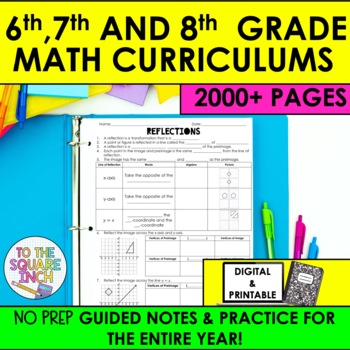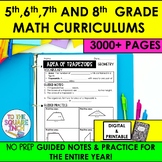6th, 7th and 8th Grade Math Guided Notes
To the Square Inch- Kate Bing Coners
16.3k Followers
Resource Type
Standards
CCSS6.G.A.1
CCSS6.G.A.2
CCSS6.G.A.3
CCSS6.G.A.4
CCSS7.G.A.1
Formats Included
- Various file types
Pages
2,648 pages
To the Square Inch- Kate Bing Coners
16.3k Followers
What educators are saying
I absolutely love this resource. I started using the individual notes last year with my students, but ended up buying the bundle for this year. It covers just about everything I need for 6th, 7th, and 8th grade. This is perfect for my intervention classes. Thank you!
Products in this Bundle (195)
showing 1-5 of 195 products
Bonus
Digital Product Links
Also included in
- 5th, 6th, 7th and 8th Grade Math Guided Notes Curriculum and Practice Bundle- Common Core Aligned for All Standards This bundle includes FREE versions of digital notes for distance learning. This bundle includes guided notes, practice activities, warm-up and exit slips for each of the 5th, 6th, 7thPrice $600.00Original Price $910.25Save $310.25
Description
6th, 7th and 8th Grade Math Guided Notes and Pratice Bundle- Common Core Aligned for All Standards
This bundle includes FREE versions of digital notes for distance learning.
This bundle includes guided notes, practice activities, warm-up and exit slips for each of the 6th, 7th and 8th Grade Math Common Core Standards. These 195 products are bundled together for over 30% off the original cost. *All notes and practice have been formatted into booklets that fit into interactive notebooks*
6th Grade Curriculum:
- Multiplying Fractions*
- Dividing Fractions*
- Dividing Mixed Numbers*
- Dividing Multi-Digit Numbers*
- Adding and Subtracting Decimals*
- Multiplying Decimals*
- Dividing Decimals by Whole Numbers*
- Dividing Decimals by Decimals*
- Greatest Common Factor*
- Least Common Multiple*
- Introduction to Integers*
- Negative Fractions and Decimals*
- Opposite Values*
- Reflecting Coordinates*
- Absolute Value*
- Comparing and Ordering Integers*
- Coordinate Plane*
- Introduction to Ratios*
- Unit Rate*
- Equivalent Ratios*
- Ratio Tables *
- Ratios with Tape Diagrams*
- Comparing Unit Rates*
- Introduction to Percents*
- Percents and Fractions*
- Percents and Decimals*
- Percent of a Number *
- Finding the Whole *
- Converting Measurements
- Area of Rectangles and Parallelograms*
- Area of Triangles*
- Area of Trapezoids*
- Area of Composite Figures*
- Volume of Rectangular Prisms*
- Volume of Rectangular Prisms with Fractional Edges*
- Distance in the Coordinate Plane*
- Polygons in the Coordinate Plane*
- Nets of 3-D Figures*
- Surface Area of Rectangular Prisms *
- Surface Area of Triangular Prisms*
- Surface Area of Pyramids
- Order of Operations*
- Algebraic Expressions Vocabulary*
- Writing Algebraic Expressions*
- Reading Algebraic Expressions*
- Evaluating Algebraic Expressions*
- Equivalent Expressions*
- Combining Like Terms*
- The Distributive Property*
- Writing Equations*
- Checking Solutions*
- Solving Equations with Addition and Subtraction*
- Solving Equations with Multiplication and Division*
- Writing Inequalities*
- Graphing Inequalities *
- Solving Inequalities with Addition and Subtraction*
- Solving Inequalities with Multiplication and Division*
- Equations in 2 Variables*
- Statistical Questions*
- Shapes of Distributions*
- Finding Mean*
- Finding Mode*
- Finding Median*
- Finding Range*
- Quartiles*
- Interquartile Range (IQR) *
- Mean Absolute Deviation (MAD) *
- Line Plots*
- Histograms*
- Box and Whisker Plots*
- Stem and Leaf Plots*
7th Grade Curriculum
- Adding Integers with the Same Sign*
- Adding Integers with Different Signs*
- Subtracting Integers*
- Multiplying and Dividing Integers*
- Terminating and Repeating Decimals*
- Adding Rational Numbers*
- Subtracting Rational Numbers*
- Multiplying and Dividing Rational Numbers*
- Ratios & Rates*
- Proportions*
- Graphing Proportional Relationships*
- Writing and Solving Proportions *
- Slope*
- Direct Variation*
- Percents, Decimals, and Fractions*
- Percent Proportion*
- Percent of Increase and Decrease*
- Discounts and Mark-Ups*
- Simple Interest*
- Tax, Tip and Commissions*
- The Percent Equation*
- Adjacent and Vertical Angles*
- Complementary and Supplementary Angles*
- Types of Triangles*
- Constructing Triangles
- Angle Measures of Triangles*
- Types of Quadrilaterals*
- Angle Measures of Quadrilaterals *
- Similar Shapes*
- Scale Drawings*
- Circle Vocabulary*
- Circumference*
- Area of Circles*
- Area of Composite Figures Involving Circles*
- Surface Area of Prisms*
- Surface Area of Pyramids*
- Surface Area of Cylinders*
- Volume of Prisms*
- Volume of Pyramids*
- Volume of Cylinders*
- Algebraic Expressions*
- Adding and Subtracting Linear Expressions*
- Solving Equations Using Addition and Subtraction*
- Solving Equations Using Multiplication and Division*
- Solving Multi-Step Equations*
- Writing and Graphing Inequalities
- Solving Inequalities Using Addition and Subtraction*
- Solving Inequalities Using Multiplication and Division*
- Writing and Solving 2-Step Inequalities *
- Populations and Samples*
- Estimating Populations*
- Measures of Central Tendency*
- Measures of Variation *
- Outcomes and Events*
- Intro to Probability*
- Experimental Probability*
- Theoretical Probability*
- Fundamental Counting Principle *
- Compound Events*
- Independent and Dependent Events*
8th Grade Curriculum
- Exponents
- Multiplying Powers with the Same Base
- Power of a Power
- Power of a Product
- Dividing Exponents
- Zero and Negative Exponents
- Square Roots
- Cube Roots
- Solving Equations Using Square and Cube Roots
- Reading Scientific Notation
- Writing Scientific Notation
- Adding or Subtracting Numbers in Scientific Notation
- Multiplying Numbers in Scientific Notation
- Dividing Numbers in Scientific Notation
- Graphing Linear Equations
- Slope of Horizontal and Vertical Lines
- Slope of a Line
- Slope of Parallel and Perpendicular Lines
- Direct Variation
- X and Y Intercepts
- Graphing Linear Equations in Slope-Intercept Form
- Graphing Linear Equations in Standard Form
- Writing Equations in Slope-Intercept Form
- Writing Equations in Point-Slope Form
- Solving Simple Equations
- Combining Like Terms to Solve Equations
- Using the Distributive Property to Solve Equations
- Solving Equations with Variables on Both Sides
- Literal Equations
- Equations with No Solutions and Infinitely Many Solutions
- Solving Systems of Linear Equations by Graphing
- Solving Systems of Linear Equations by Substitution
- Solving Systems of Linear Equations by Elimination Using Addition
- Solving Systems of Linear Equations by Elimination Using Subtraction
- Relations and Functions
- Representations of Functions
- Linear Functions
- Linear and Nonlinear Functions
- Sketching Functions
- Classifying Real Numbers
- Rational Numbers as Decimals
- Approximating Square Roots
- Comparing and Ordering Real Numbers
- Congruent Figures
- Translations
- Reflections
- Rotations
- Composite Transformations
- Dilations
- Similar Figures
- Parallel Lines and Transversals
- Interior and Exterior Angles of Triangles
- Angles of Polygons
- Similar Triangles
- Pythagorean Theorem
- Converse of the Pythagorean Theorem
- Distance in the Coordinate Plane
- Volume of Cylinders
- Volume of Cones
- Volume of Spheres
- Scatter Plots
- Lines of Fit
- Two-Way Frequency Tables
Total Pages
2,648 pages
Answer Key
Included
Teaching Duration
1 Year
Report this resource to TPT
Reported resources will be reviewed by our team. Report this resource to let us know if this resource violates TPT’s content guidelines.
Standards
to see state-specific standards (only available in the US).
CCSS6.G.A.1
Find the area of right triangles, other triangles, special quadrilaterals, and polygons by composing into rectangles or decomposing into triangles and other shapes; apply these techniques in the context of solving real-world and mathematical problems.
CCSS6.G.A.2
Find the volume of a right rectangular prism with fractional edge lengths by packing it with unit cubes of the appropriate unit fraction edge lengths, and show that the volume is the same as would be found by multiplying the edge lengths of the prism. Apply the formulas 𝘝 = 𝘭 𝘸 𝘩 and 𝘝 = 𝘣 𝘩 to find volumes of right rectangular prisms with fractional edge lengths in the context of solving real-world and mathematical problems.
CCSS6.G.A.3
Draw polygons in the coordinate plane given coordinates for the vertices; use coordinates to find the length of a side joining points with the same first coordinate or the same second coordinate. Apply these techniques in the context of solving real-world and mathematical problems.
CCSS6.G.A.4
Represent three-dimensional figures using nets made up of rectangles and triangles, and use the nets to find the surface area of these figures. Apply these techniques in the context of solving real-world and mathematical problems.
CCSS7.G.A.1
Solve problems involving scale drawings of geometric figures, including computing actual lengths and areas from a scale drawing and reproducing a scale drawing at a different scale.



